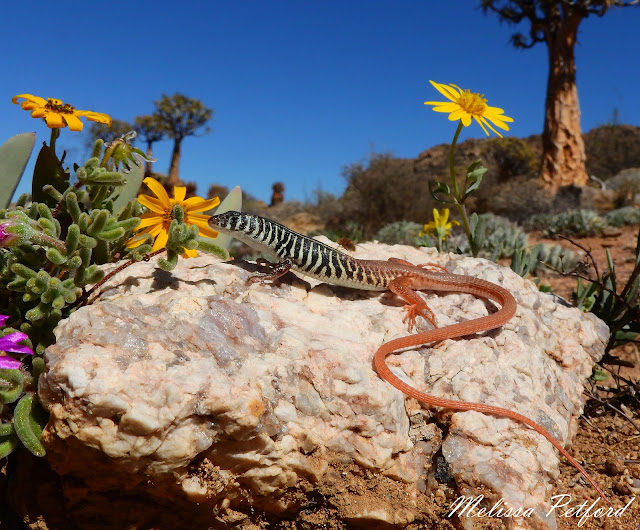 |
| Large female Parabuthus transvaalicus, Soutpansberg, Limpopo. |
At 23:01, 12 December, 2017 at Goro Game Reserve,
Soutpansberg Limpopo, I was stung by a medium sized male Parabuthus transvaalicus on
the top of middle finger just below the nail. Sting was received while attempting to
capture small mammal – I accidently brushed up against scorpion, which was
between rock and clump of grass. Scorpion was only seen after the sting.
Immediate and extreme pain followed from site of sting. Within minutes, pain could be felt spreading up arm, very soon becoming unbearable and highly uncomfortable. Lymph node under armpit (axillary) became tender very quickly. In ten minutes pain seemed to reach peak in intensity and strange sensation (dull paraesthesia) could be felt in nerves in chest near axillary nymph node to about middle of chest. This persisted and was intensely uncomfortable for about three hours. After that chest paraesthesia was very slight but lymph node remained painful and uncomfortable well into the night.
 |
| Puncture mark on middle finger after sting from medium sized Parabuthus transvaalicus. |
Thirty minutes after sting, pain
remained intense but was not as heightened as first twenty minutes. Two hours
later intense pain had subsided dramatically and local throbbing pain at site
of sting coupled with extreme discomfort was present throughout the night, at
times waking me up, relief was gained by elevating hand.
Finger was hypersensitive
(hyperaesthesia) and any stimulation (touching something, being touched) would
immediately send painful jolts of pain coursing up my arm. Pain had an electric
quality to it.
Twelve hours later – pain very much
still present at site of sting. Continued paraesthesia, limited movement of
finger and hypersensitivity (even running finger under tap was painful). Finger
very slightly swollen and skin on finger clammy with localised perspiration
visible. No swollen lymph at this stage. Pain and discomfort limited to finger
unless finger stimulated; a light bump would send shooting
Throughout the first day after sting, a
feeling of nausea and persistent headache was present. Tried to remedy with
rehydration salts but no improvement. Late afternoon I used an analgesic
(codeine, ibuprofen and paracetamol), which took away headache but was still
unable to use finger due to hyperaesthesia and pain. Every time finger touches
something sensitivity is inline with intensity of touch: light touch – slight tingling; light squeeze
– strong paraesthesia; gentle bump against body or clothing – intense pain up
finger; hard bump against body, clothing or object – intense pain shooting up
finger all the way to elbow. Shooting
pain had an electric quality to it.
After 24 hours paraesthesia persisted:
strange tingling pain shooting up to elbow every time finger touches something
or bumps against something. Headache no longer present but still experienced
occasional nausea. Unable to use hand properly as finger is too sensitive. Any
touch to finger causes uncomfortable tingling sensation with varying amounts of
pain as described above.
After 32 hours, still had tingling
sensation on finger where stung, finger still hypersensitive and out of use
every time it is stimulated pain and discomfort is present as described above.
Able to curl finger with difficulty. No headache or nausea.
After 96 hours (four days after sting) no
symptoms besides mild paraesthesia on finger and light hyperaesthesia. Using
finger is unpleasant but not unbearable due to uncomfortable feeling. Intensity
of pain discomfort experienced when finger is stimulated much lower but still
present and still very painful when bumped.
120 hours later. Very light
paraesthesia and hypaesthesia present. Finger is usable for light tasks but
with moderate pain when bumped hard. Finger has a little bit of a dead feel to
it.
144 hours later, finger is basically
back to normal. Occasional dull pain when bumped. Sense of hyperaesthesia
barely present with sporadic periods of pins and needles and sensation of
deadness on finger. Able to use hand normally, no more sharp pain when finger
is stimulated only paraesthesia.
168 hours later (one week) finger back
to normal, irregular bouts of hyperaesthesia especially after immersing in
water. No more pain at site, no more symptoms to report.
 |
| Male Parabuthus transvaalicus exhibiting venom droplets on back, Soutpansberg, Limpopo. |
In way of summary I would like to
express a few things I thought about while experiencing my first serious
envenomation. Firstly, sting could have
been prevented if I had been more careful where I put my hands. Caught up in a
chase to capture an elephant shrew I tried to block his exit and brushed up
against unseen scorpion in ambush position. Secondly, I never
used any first aid besides elevating limb, if I could recommend some measures I
would say elevate affected area and minimise use of appendage and rest.
Unfortunately after sting I still had a very long walk ahead of me. Ice or hot
water would not have been an option, as pain would have been excruciating
because of hyperaesthesia. Thirdly even though I
never went to hospital or sought medical advice I would say sting was
definitely a serious injury. Luckily the dull paraesthesia experienced in my
chest never developed into more serious complications, it certainly did give me
cause for concern, had the scorpion been larger and had I been a smaller
person, I can imagine the sting being more serious and potential for
complications to arise higher. In the first ten minutes of the pain there was
also a psychological element, of panic and anxiety due to the intensity of
pain. It was quite easy for me to calm down quickly as I am familiar with the
species and know that human fatalities probably unheard of, but I can imagine
the psychological panic could further complicate the severity of the situation.

























































